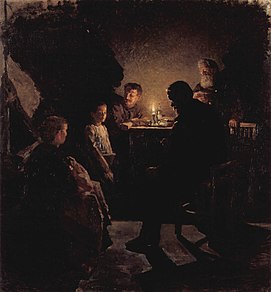
Nikolay Alekseyevich Kasatkin (Russian: Никола́й Алексе́евич Каса́ткин; 13 December 1859, Moscow – 17 December 1930, Moscow) was a Russian painter; considered to be one of the founders of Social Realism in Russia.
Biography

His father was an engraver and lithographer. [1] From 1873 to 1883 he studied at the Moscow School of Painting, Sculpture and Architecture with Vasily Perov and Illarion Pryanishnikov. [2] Upon graduating, he received a medal for his painting "Beggars at the Church Door". [1]
In 1891, he began exhibiting with the Peredvizhniki and, from 1894 to 1917, was a teacher at his alma mater. For thirty years, beginning in 1883, he worked with Ivan Sytin, providing illustrations for his popular almanac/calendars and teaching lithography. [2] He also contributed to Великая реформа (The Great Reform), an encyclopedia that celebrated the fiftieth anniversary of the Emancipation, and a collection called "Russian History in Pictures".
In 1903, he became a member of the Imperial Academy of Arts. [2] He participated in the Exposition Universelle (1900), where he won a silver medal, [1] and the Louisiana Purchase Exposition (1904), among others. The following year he produced a series of works inspired by the Revolution of 1905.
After the October Revolution, his school was closed and later incorporated into " Svomas" as the "Second Free Art Studio". He continued teaching, however, for the Department of Education of the Sokolniki District Council. [1] In 1923, following the Civil War, he was named the first "People's Artist of the Republic" and became a member of the AKhRR (Association of Artists). [2]
In 1924, he went to England to document the lives of the proletariat there. Two years later, he created portraits for the "Museum of the Revolution" (since 1998, the " Central State Museum of Contemporary History"). He is considered to be one of the forerunners of Socialist Realism in the arts and was sometimes called the " Gorky of Painters".
He died suddenly while giving a presentation of his latest painting at the above Museum. [2] In 1956, the Soviet Union honored him with a 40 kopeck commemorative postage stamp. In 1971, his painting of a female mine worker was featured on a 6 kopeck stamp as part of a series of works by Soviet artists. A street in Moscow has been named after him.
Selected paintings
-
Who!?
-
A Worker's Family
-
The Poor, Picking up
Pieces of Coal -
In the Corridor of
the District Court
References
Further reading
- Yakov Minchenkov, Касаткин Николай Алексеевич, "Memories of the Peredvizhniki" series, Litres, 2013
ISBN 5-457-13081-9 - Henrietta Serova, Николай Алексеевич Касаткин, "People's Art Library", Художник РСФСР, 1970
- V.V. and E.A. Zhuravlyev, Николай Алексеевич Касаткин, народный художник: 1859-1930 (The People's Painter), Искусство, 1945
External links
![]() Media related to
Nikolay Alekseyevich Kasatkin at Wikimedia Commons
Media related to
Nikolay Alekseyevich Kasatkin at Wikimedia Commons

Nikolay Alekseyevich Kasatkin (Russian: Никола́й Алексе́евич Каса́ткин; 13 December 1859, Moscow – 17 December 1930, Moscow) was a Russian painter; considered to be one of the founders of Social Realism in Russia.
Biography

His father was an engraver and lithographer. [1] From 1873 to 1883 he studied at the Moscow School of Painting, Sculpture and Architecture with Vasily Perov and Illarion Pryanishnikov. [2] Upon graduating, he received a medal for his painting "Beggars at the Church Door". [1]
In 1891, he began exhibiting with the Peredvizhniki and, from 1894 to 1917, was a teacher at his alma mater. For thirty years, beginning in 1883, he worked with Ivan Sytin, providing illustrations for his popular almanac/calendars and teaching lithography. [2] He also contributed to Великая реформа (The Great Reform), an encyclopedia that celebrated the fiftieth anniversary of the Emancipation, and a collection called "Russian History in Pictures".
In 1903, he became a member of the Imperial Academy of Arts. [2] He participated in the Exposition Universelle (1900), where he won a silver medal, [1] and the Louisiana Purchase Exposition (1904), among others. The following year he produced a series of works inspired by the Revolution of 1905.
After the October Revolution, his school was closed and later incorporated into " Svomas" as the "Second Free Art Studio". He continued teaching, however, for the Department of Education of the Sokolniki District Council. [1] In 1923, following the Civil War, he was named the first "People's Artist of the Republic" and became a member of the AKhRR (Association of Artists). [2]
In 1924, he went to England to document the lives of the proletariat there. Two years later, he created portraits for the "Museum of the Revolution" (since 1998, the " Central State Museum of Contemporary History"). He is considered to be one of the forerunners of Socialist Realism in the arts and was sometimes called the " Gorky of Painters".
He died suddenly while giving a presentation of his latest painting at the above Museum. [2] In 1956, the Soviet Union honored him with a 40 kopeck commemorative postage stamp. In 1971, his painting of a female mine worker was featured on a 6 kopeck stamp as part of a series of works by Soviet artists. A street in Moscow has been named after him.
Selected paintings
-
Who!?
-
A Worker's Family
-
The Poor, Picking up
Pieces of Coal -
In the Corridor of
the District Court
References
Further reading
- Yakov Minchenkov, Касаткин Николай Алексеевич, "Memories of the Peredvizhniki" series, Litres, 2013
ISBN 5-457-13081-9 - Henrietta Serova, Николай Алексеевич Касаткин, "People's Art Library", Художник РСФСР, 1970
- V.V. and E.A. Zhuravlyev, Николай Алексеевич Касаткин, народный художник: 1859-1930 (The People's Painter), Искусство, 1945
External links
![]() Media related to
Nikolay Alekseyevich Kasatkin at Wikimedia Commons
Media related to
Nikolay Alekseyevich Kasatkin at Wikimedia Commons



